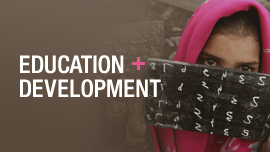When we think of “education,” we often picture schools, teachers, and books. However, education is a complex and multifaceted system, much like a machine, with a wide array of interconnected components working together to shape individuals who ideally are holistically empowered with the knowledge, skills, mindsets, attitudes, and abilities to thrive. While visible components of education—such as infrastructure, teachers, and teaching and learning materials—typically drive policy and programmatic efforts, invisible elements like mindsets, cultural norms, power dynamics, and system inertia are frequently overlooked. These unseen components, like oil lubricating machine gears, profoundly impact education system functioning and transformation. Yet, due to their intangibility, their critical role in either enabling or hindering sustainable transformation has often been ignored.
Despite increased investments in the visible components of education, recent global data reveal that less than half of youth, particularly those in Global South contexts, are on track to attain the range of skills needed to thrive in school, work, and life. As such, understanding both the visible and invisible components of education, along with the barriers and enablers that influence their functioning, is essential for creating education systems that provide a breadth of learning opportunities and nurture the skills that children and young people need.
Systemic enablers and barriers in education systems
Both system enablers and barriers operate in visible and invisible manners that ultimately shape education systems and their effectiveness. The visible elements—like infrastructure and technological tools—are akin to the exterior structure of a machine, providing the essential environment for learning. The invisible components may include deeply ingrained mindsets, cultural norms, and power dynamics, which regulate how education is perceived, implemented, and delivered. The intersectionality of system enablers and barriers creates complex challenges that must be addressed to transform education systems effectively.
On one hand, system barriers can prevent education systems from functioning optimally. Missing or broken components—like technical education infrastructure or usable toilets—can discourage regular school attendance, while skill mismatches with labor market demands leave students unprepared for future employment. Invisible barriers are particularly challenging, as they tend to be much more nuanced and are often defended as “standard practice” rather than recognized as systemic issues that can be redesigned. For example, when mindsets and cultural norms remain rigid, inequities persist, power structures may resist shifts, and even well-designed interventions may struggle to create lasting desired impact.
Conversely, enablers can facilitate the transformation of structures and processes within education systems. Inclusive education policies, for instance, promote equitable access regardless of background, as seen in Mexico’s Escuelas de Tiempo Completo (Full-Time Schools) program, which extended school hours and provided meals for low-income students by offering additional learning opportunities and nutritional support. Community engagement likewise works to foster shared responsibility and improves system effectiveness. When invisible elements are intentionally addressed by fostering openness to change, promoting inclusive decisionmaking, and challenging entrenched biases, they may become powerful catalysts for deep, systemic transformation beyond surface-level reforms.
Approaching the complexity of education systems
To better understand the multifaceted and interconnected components and interactions that shape education systems, members of Network for Education Systems Transformation (NEST) argue that we must shift research and policy approaches from linear, one-size-fits-all solutions to context-sensitive, adaptive strategies. Since early 2024, NEST member organizations SmartStart (South Africa), Vía Educación (Mexico), and Dream a Dream (India) have conducted context-specific research, with SmartStart and Vía Educación implementing dynamic system mapping exercises to capture diverse perspectives and context-specific data. These exercises work to provide researchers and policymakers a deeper understanding of educational ecosystems, emphasizing interdependent relationships among system actors, resources, processes, and structures, while identifying barriers and leverage points for system transformation.
Improving the functioning of education systems: Lessons from India, Mexico, and South Africa
Once system components and roles are identified, it becomes easier for actors across the system to align around actionable transformation strategies:
- In India, Dream a Dream found that entrenched mindsets equating success solely with academic performance pose significant barriers to advancing holistic education. Recognizing these challenges, the organization is driving systemic change in public education by integrating Social and Emotional Learning into teacher training, curriculum development, assessment reform and policy advocacy, shifting mindsets toward a broader vision of success focused on enabling all young people to thrive.
- Mapping exercises from Vía Educación and SmartStart revealed invisible barriers like unequal power dynamics—such as authority concentration at certain levels of the education system—can create bottlenecks or negative reinforcing loops, hindering the resource flow and system potential. In South Africa, systemic poverty and inequality shaped by race, class, gender, and geography have created deep fault lines affecting early learning access and quality, reinforcing existing inequalities.
To dismantle these constraints, strategic, cross-sector collaboration must transcend conventional silos. By leveraging institutional capacities and diverse expertise locally, actors may begin to build shared understanding of systemic challenges and generate coordinated actions that are fitted to local realities. This approach depends on cultivating an often-invisible enabler—relational trust and genuine belonging among diverse actors—which serves as a critical accelerant for fostering commitment, collaboration, and transformation.
Takeaways
Education system transformation requires deep understanding of the interplay between visible and invisible components and identifying key obstacles and leverage points. Since education systems are complex with deeply interrelated components, addressing barriers or leveraging enablers requires systemic thinking and focused on the interactions between components.
Most importantly, shifting the mindsets of education system actors is necessary for a well-functioning system. This goes beyond curriculum, pedagogy, and assessment, reimagining education as a space for holistic development rather than mere academic achievement, where policymakers, educators, and communities embrace learning as a lifelong, evolving process fostering adaptability, well-being, and critical thinking in young people.
-
Acknowledgements and disclosures
This blog has grown out of the collaborative work of the Network for Education Systems Transformation (NEST). Special thanks to NEST member Anne McLennan for reviewing this blog.
The Brookings Institution is committed to quality, independence, and impact.
We are supported by a diverse array of funders. In line with our values and policies, each Brookings publication represents the sole views of its author(s).







Commentary
The mechanics of transformation
Visible and invisible components that shape education systems
May 27, 2025